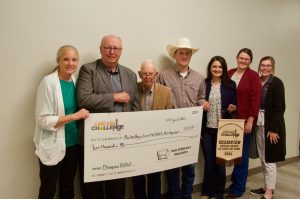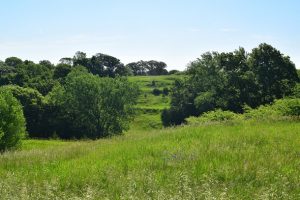CLICK HERE for the latest market quotes from the Iowa Agribusiness Network!
CLICK HERE for the latest market quotes from the Brownfield Ag News Network!
CLICK HERE for the latest market quotes from the Iowa Agribusiness Network!
CLICK HERE for the latest market quotes from the Brownfield Ag News Network!
The Iowa Cattlemen’s Association Carcass Challenge program is a yearly effort to showcase Iowa’s beef cattle genetics in the only statewide fed-beef competition. The 2021 program completed with an awards banquet held in early June. Steer sponsors donated 74 700-pound steers in November, which were delivered to Lauritsen Cattle Company, in Exira, to be fed out to 1,400 pounds in the 180- to 200-day time period. The top 10 percent of individuals were recognized based on the Retail Value Per Day on Feed (RVDoF), with a top cash prize of $5,000. The RVDoF formula is a dollar value that accounts for hot carcass weight, percent retail product, carcass price and days on feed, balancing the important factors that ultimately drive profitability.
The champion steer for the 2021 ICA Carcass Challenge with an RVDoF of $6.21 was awarded to steer 53, donated by Mosher Angus, Lauritsen Cattle Company and Mark Segebart, and the steer was bred by Mosher Angus.

Pictured (Left to Right): Cathy and Mark Segebart, Norval Mosher, Ty Lauritsen, Clara Lauritsen, Lauren Mosher, Leah Mosher
The award for largest ribeye, with a ribeye area of 16.29 square inches, was steer 43, donated and bred by Johnson Family Farms. The high marbling award winner was steer 4, donated by American State Bank, and bred by Trent Rehder, with a marbling score of 698. The Chef’s Choice award was developed with the goal of identifying the most economically efficient steer and to determine the genetic potential of individual animals to produce the safest, most nutritional and most desirable food product possible. This year’s winner of the Chef’s Choice award was steer 71, donated by the Woodhill Farms, Cherne Angus and Hosch Farms, and bred by Cherne Angus. The highest average daily gain was figured for the time the steers were on test, from November 17, 2020 to May 7, 2021. This year’s winner with an average daily gain of 5.31 pounds per day was steer 24, donated by Custom Precast and bred by Jason Kurt.
The sponsors of the 2021 program included Elanco, Lauritsen Cattle Company, Gregory Feedlots, the CUP Lab, Producers Livestock, Stuart Veterinary Service and Shawn Nicholsen, Tri-County Steer Carcass Futurity, Allflex, Rueters Equipment and the Audubon County Cattlemen. The 2022 ICA Carcass Challenge recruitment will begin soon. For more information regarding the program, contact Jennifer Carrico at jennifer@iacattlemen.org.
(Radio Iowa) – A year ago in the midst of the pandemic, the price spread between packers and cattle producers rose to 1500 percent and John Tupper, vice president of the U-S Cattlemen’s Association, says the four big meat packers still are making significant profits. “Packers have enjoyed unbelievable profits,” Tupper said, “harvesting around 120,000 head per day while cattle producers go out of business and consumers pay double or even triple at the meat counter.”
Tupper, an auctioneer and cow-calf operator from South Dakota, testified during a U-S Senate Ag Committee hearing Wednesday afternoon. Farm state lawmakers are considering bills that would give independent livestock operators more information about prices, as many cattle sales are now private. “There is a crisis in rural America. We are losing our producers at an alarming rate,” Tupper says, “all the while watching big corporate feeders, packers make record profits with the threat of verticle integration hanging over our head.”
There were about three-point-six MILLION head of cattle and calves in Iowa on January 1st, down more than 200-thousand from the previous year. Tupper says a steer is worth about 16-hundred dollars today. “Packers could buy that steer and sell it for beef alone, not counting byproducts, for over $2800 a head today,” he says, “for a gross profit margin of over 80%.”
The North American Meat Institute, a trade group representing meat packers, says prices are following market trends as supply for meat struggles to keep pace with demand. Iowa now ranks eighth among the states in cattle production.
Effective Noon today (Wed., June 23rd), a Burn Ban is in place for all of Audubon County. Audubon Fire Chief Tyler Thygesen, acting on behalf of all fire departments in the County, requested the ban be issued by the State Fire Marshal’s Office. The ban prohibits any open burning due to the fact conditions in the County are such that any such activity would constitute a danger to life or property.
 No person in Audubon County shall engage in open burning in the County – except as specifically permitted by Iowa Code, until such time as Thygesen notifies the State Fire Marshal that the dangerous conditions no longer exist. Any violation of the Burn Ban is a simple misdemeanor.
No person in Audubon County shall engage in open burning in the County – except as specifically permitted by Iowa Code, until such time as Thygesen notifies the State Fire Marshal that the dangerous conditions no longer exist. Any violation of the Burn Ban is a simple misdemeanor.
(Iowa DNR News) – One of Iowa’s newest public wildlife areas is in the backyard of Council Bluffs and outside of a few keen-eyed hunters who noticed the green signs last fall, not many people know about it. Yet. “There’s a huge constituency in Council Bluffs with limited places to hunt and this is about five miles away,” said Matt Dollison, wildlife biologist with the Iowa Department of Natural Resources (DNR). The 513-acre Green Hill Wildlife Area is in the early stages of being transformed from row crops and introduced brome grass, into native prairie.
Standing on a ridge looking northwest over the Google campus, the skyline and noise of Omaha and Council Bluffs fades and the sound of Field sparrows, vesper sparrows, eastern towhees, common yellowthroats replaces the sound of traffic. Cattle grazed on a portion of the area, but have been removed and Dollison plans to burn it next spring to see what native plants come back. Walking one of the terraces, he points to big bluestem, blazing star, purple prairie clover, leadplant, whorled milkweed and Indian grass. “Native prairie is coming up in the brome so that tells me that when we burn this, we’ll be in business,” Dollison said. He’s working with two seed dealers and the DNR wildlife unit in Onawa to source local loess hills prairie grasses and flower seed to fill in the gaps and keep the reconstructed prairie here as close as possible to what was initially here.

Green Hill Wildlife Area offers visitors a chance to unwind, go hiking, birdwatching, mushroom hunting, or just to look at and enjoy the prairie. It’s also a place close to home to hunt deer, turkeys, squirrels and pheasants and quail. Photo courtesy of the Iowa DNR.
The plan is to covert 20-30 acres of the former crop ground into prairie each year for the next four years. They planted a 27-acre field this spring. “We’re going to leave about 10 percent for row crops, alfalfa, food plots and sunflowers fields, but the rest will go to prairie,” Dollison said. They’ve been working with a farmer in the area to plant the crops and sunflower fields, and to help with mowing and spraying. They plan to work with a producer to continue grazing cattle on part of the area. “Grazing will continue to be one of the management practices here, alternating grazing with an idle year or two in between. That will help our cooperator and the disturbance will help diversify the native prairie,” he said.
Green Hill is across 221st Street (old Hwy. 275) from Folsom Point Preserve, a private preserve owned by The Nature Conservancy. The preserve is home to the Great Plains skink, plains pocket mouse, ornate box turtle and Henslow’s sparrow – all species in need of more habitat. A western prairie fringed orchid has been found a mile east of Green Hill. It’s possible that once Green Hill is converted to prairie, that those species could call it home as well. “I asked our wildlife techs to keep their eyes out for rare species when they’re working over here,” he said.
About 20 percent of Green Hill is timber and most of that is a mix of oak and hickory. Dollison will work with the district forester to write a forest wildlife management plan for the area. In the not too distant future, the trees will be gone in an effort to enhance prairie habitat, and Green Hill will look quite a bit different than it does today. Green Hill offers visitors a chance to unwind, go hiking, birdwatching, mushroom hunting, or just to look at and enjoy the prairie. It’s also a place close to home to hunt deer, turkeys, squirrels and pheasants and quail. Just be sure to keep a sharp eye out for the gravel access lanes off 221st Street.
Battling the invaders
Green Hill Wildlife Area has its share of unwanted invasive species and among the worst is black locust and crown vetch. It also has tree of heaven, Siberian elm and honeysuckle. “If you cut black locust and tree of heaven and spray the cut stump, they can send suckers up from their roots and that makes them difficult to kill,” Dollison said. “We’re using a technique of spraying around the base of the trunk to kill it slowly which prevents them from sending out the suckers.”
Partners in Green Hill
The acquisition of Green Hill was years in the making and finalized on June 29, 2020, through a partnership with The Nature Conservancy, the Iowa Natural Heritage Foundation and the Iowa DNR, using multiple funding sources including the Iowa West Foundation, U.S. Fish and Wildlife Service and Pittman-Robertson.
(Radio Iowa) – Demand for beef is high in grocery stores in Iowa and across the U-S as beef prices are sharply rising, but while there’s plenty of supply, many cattle producers are struggling financially. The lack of transparency in cattle markets is the subject of a hearing tomorrow (Wednesday) before the U-S Senate Agriculture Committee, where Iowa Senator Chuck Grassley is the ranking Republican. “Independent cattle farmers are losing money on each head of cattle while packers are profiting, sometimes up to $1,200 per head,” Grassley says. “One week, it was only $800, but just think of that profit when the farmers are losing money.”
Consumers and producers are being hurt by consolidation of the cattle industry, Grassley says, and he’s called for a hearing on the topic for months. “These farmers have every reason to be fed up with the anti-competitive practices of the marketplace,” Grassley says. “And how anti-competitive? Four big packers kill 80% of the cattle in this country. The system is clearly broken.”
Grassley says he’s hearing pleas for changes in the industry from members of the Iowa Cattlemen’s Association and individual producers who are being negatively affected by consolidation. Farmers claim the big packers are intentionally manipulating beef prices. “The situation is that a farmer that doesn’t precontract has a hard time getting a decent price,” Grassley says, “and sometimes even after he gets a price, ‘Well, we’ll take your cattle in maybe three weeks or a month,’ and in the meantime, you feed them seven-dollar corn.”
Earlier this year, Grassley introduced a bill he says is designed to foster efficient markets while boosting competition and transparency among meatpackers. With this hearing, he says he’s hopeful his legislation will gain support or that a compromise can be reached. Tomorrow’s hearing is scheduled for 1:30 PM/Central.
(Radio Iowa) – John Deere is known for its green tractors and combines but is celebrating the anniversary of its first backhoe loader introduced 50 years ago in 1971. Deere Product Manager, Brian Hennings, says the loader on the front and excavator on the back, and the ability to drive it to and from job sites makes it popular. “The machine is really one of the most versatile pieces of equipment out on a job site. Some compare it to a Swiss army knife of construction equipment,” Hennings says.
 The company makes backhoe loaders in Dubuque, Iowa, plus Brazil and China. Hennings says the general concept has stayed the same since 1971 — but nearly everything else has changed — including the engines, hydraulic systems, and transmissions to keep the machine a valuable tool. ” It can load trucks, it can stockpile materials, trench with the rear structure, dig holes and access utilities and other types of underground surfaces then you can turn it right around and backfill into the trenches,” Hennings says.
The company makes backhoe loaders in Dubuque, Iowa, plus Brazil and China. Hennings says the general concept has stayed the same since 1971 — but nearly everything else has changed — including the engines, hydraulic systems, and transmissions to keep the machine a valuable tool. ” It can load trucks, it can stockpile materials, trench with the rear structure, dig holes and access utilities and other types of underground surfaces then you can turn it right around and backfill into the trenches,” Hennings says.
Deere does not reveal sales and production figures, but will say prices for its seven models range from 114-thousand to 222-thousand dollars. Deere has begun testing its first electric model, but any large-scale production is still some years away.
(Radio Iowa) Weekend rains were welcome — but the latest U-S-D-A report shows the drought impact is showing in Iowa’s crops. Farmers reported the corn leaves curling and ground cracking in some areas of the state from the heat. The U-S-D-A report shows the corn condition is rated 56 percent good to excellent — a drop of seven percentage points from last week. Soybean emergence was 96 percent complete, one week ahead of the five-year average.
The soybeans were rated at 57 percent good to excellent — which is a four percent drop from the prior week.
(Radio Iowa) – Trees Forever will be hosting an online seminar over the noon hour today (Tuesday) to showcase Iowa’s tallest trees. Jeff Jensen, an Iowa field coordinator for Trees Forever, says these trees dwarf the landscape. “We were able to secure Mark Rouw,” Jensen says. “He’s kind of known as the ‘big tree expert’ here in Iowa. He’s been all over the state.” Rouw keeps a spreadsheet of the state’s tallest trees. Jensen says Rouw will explain how he measures the trees, where he goes to look for them and some of the national champion trees in Iowa.
“And just gives just a really nice overview, including just some fantastic photos,” Jensen says. State officials say Iowa has about three MILLION acres of trees and forest areas. Jensen says while Iowa is known as a tall grass prairie state, it has some tall trees, too. “As you can imagine, for a tree to get real large to be considered a national champion or a state champion, it has to have a very long life,” Jensen says.
Find out more about today’s (Tuesday’s) webinar at www.radioiowa.com. The state’s list of tall trees shows a dozen trees are over 100 feet tall. It includes a sugar maple in Clayton County; a European Alder in Davenport; a Bitternut Hickory and a couple of Black Walnuts in Des Moines; a Black Ash in Anamosa; plus three Yellow Poplars in Indianola, Davenport and Burlington. Three Eastern White Pines in Iowa are among the tallest. One is in Fayette County. The other two are at White Pine Hollow State Preserve in Dubuque County.